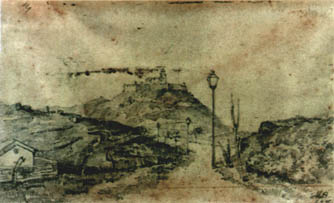
Guia Hill.
MARCIANO BAPTISTA.
Ca 1875-1880. Pencil on paper.
This drawing illustrates well the bare vegetation of the Macao shortly before the Colony's government decided to plan sixty thousand trees in the peninsula.
~$S 1. ORIGINS AND BACKGROUND TO THE POLICY OF PLANNED TREE PLANTING IN THE TERRITORY
Up until the 1880s, the first impression on arriving in Macao was not one of a place covered in greenery but rather the image of arid mountains and a barren landscape with a row of houses etched into patches of red gravel. This sad picture changed dramatically after that period, according to the Count of Arnoso, because only between 1883 and 1887 the Governor, Tom~'as de Sousa Rosa [Thomas de Souza Roza], ordered the planting of sixty-thousand trees, thereby marking the beginning of a deliberate and systematic policy. Seeing this in relationship to the population Census which had been carried out a few years earlier, it was equivalent to one tree per inhabitant. However, this policy was one aspect of an overall objective initiated at the time in the Plano de Melhoramentos do Porto & Plano de Melhoramento de Macau (Plan for Improving the Port and the Plan for Improvements in Macao) . What follows is how this all came about briefly analysed in context.
The Census taken throughout Macao's entire district of the 31st of December 1878, counted "[...] sixty-eight-thousand and eighty-six inhabitants of Chinese, European and other nationalities." Within the town itself, considering it was actually a small Territory, there was already a population of fifty-nine-thousand nine-hundred and fifty-nine people, including inhabitants on land and sea.
Adolpho Loureiro [...], in his O Porto de Macau: Ante projecto para o Seu Melhoramento (Macao's Port: A Draft for Improving the Area), taking into account errors in the Census, he estimated and in-creased the overall population of Macao to around one-hundred-thousand. Yet on analysing such discrepancies in estimating the existing population, it was evident that people were already causing a great impact on the physical space available, thereby requiring measures in town planning to be adopted from early on. Nevertheless in spite of the Portuguese having settled in the area since the 1550s (since 1557), it is only possible to discuss Macao, within a systematic analysis of town planning, bearing in mind politics, art, science, and the practice and application of the organisation and overall management of the area, from 1880 onwards. The objectives of this town planning, defined after that in the collection of Annual Reports from different administrative bodies, showed on the one hand a great concern for the vital and strategic role of the port, with its serious problem of silting up, for the economy and commercial activity of the town, and for the equally very pressing concerns for sanitary conditions aimed at setting up urban planning, the support of a network of vital infrastructures and the creation of healthy environmental conditions for the inhabitants.
It is interesting that the strategic understanding of this town planning, which focused on the Porto de Macau (Port of Macao) as a vital question on which everything depended, and faced with the serious situation of existing unsanitary conditions in the Territory, there were already indications in some areas of urban intervention, classified today as very modern in many aspects, with principles of ecological measures, techniques and dynamic, progressive methods. Such proposals for town planning could be considered innovative in a certain way, even on a global scale, whether as far as the project for a practical concept of 'zoning'; defining specific areas for dangerous and polluting activities, or adopting a practical policy which had nothing to do with the forms of rigid, static town planning. It can be summed up by the following points:
1. Existence of the -- (Decreto (Decree) of the 31st of December 1864) controlling the development of the so called framework of the Planos de Melhoramentos [...] (Plans for Improvements [...]).
2. Assertion of the priority of the plan for organising Macao's entire harbour and town area, a total departure from the random development made since its initial establishment;
3. Within the scope of the Plano dos Melhoramentos do Porto [de Macau] (Plan for Improving the Port [of Macao]) was fighting causes of the river silting up by guaranteeing the conditions for minimum access to vessels and the creation of shelter in the case of typhoons and bad weather;
4. Within the scope of the Plano de Melhoramentos [da Cidade] de Macau (Plan for Improving [the Town] of Macao), adhering to the designs for construction alignments of the plan;
5. Submitting the carrying out of the Plano de Melhoramentos ao Direito (Plan for Improvements to the Law), according to legal criteria, especially with regard to the necessary expropriations and construction regulations, whether in the Portuguese or Chinese area of town;
6. Rigid execution of a methodical and progressive policy, of regularising the urban plan and the sanitation of the neighbourhoods, the infrastructure and equipment, all anticipated over a period of approximately fifteen years with regard to the Chinese city, whose construction from the start was short-term and shoddy; voicing of regulation difficulties in the design of the Portuguese city due to the high costs of those buildings already there;
7. Reformulation of the process of growing rice, tree planting on the banks, the creation and control of a network for the treatment of waste with feasible methods of biotransformation, working in with agriculture, adoption of an adequate system for the collection of rubbish within the city, drying out the swamps and continuous dredging of the river, carrying out earth filling and evening out the coastline, so that silting up is reduced;
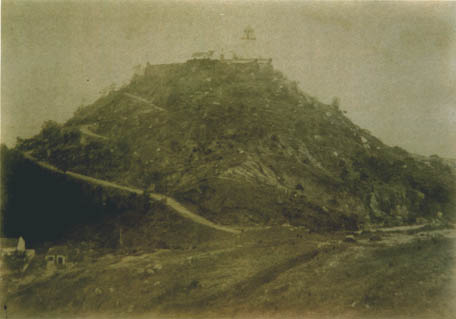 Colina da Guia (Guia Hill).
In: "Jornal ~'unico", Macau, 20 de Maid [May] 1898.
The photograph shows the hillside already planted with numerous small trees, pp. See: DEPARTMENT OF PUBLIC WORKS OF THE PROVINCE OF MACAO AND TIMOR / Chart of the trees planted in Macao during the last three years (Dated: "1st of July 1886") -- "Montanha da Guia"; DEPARTMENT OF PUBLIC WORKS OF MACAO / Chart of the trees planted in Macao during the current year (Dated: "30th of June 1887') -- "Serra da Guia".
Colina da Guia (Guia Hill).
In: "Jornal ~'unico", Macau, 20 de Maid [May] 1898.
The photograph shows the hillside already planted with numerous small trees, pp. See: DEPARTMENT OF PUBLIC WORKS OF THE PROVINCE OF MACAO AND TIMOR / Chart of the trees planted in Macao during the last three years (Dated: "1st of July 1886") -- "Montanha da Guia"; DEPARTMENT OF PUBLIC WORKS OF MACAO / Chart of the trees planted in Macao during the current year (Dated: "30th of June 1887') -- "Serra da Guia".
8. Instigation of a policy of planned landscaping throughout the Territory at the height where it is described as very arid and barren, the creation of gardens and rejuvenation of existing ones, in conflict with the Chinese peoples' reaction to this for they superstitiously believe that disturbing a tree's roots will unsettle the peace of their dead;
9. Exploration of new water sources, improving those already in use and the proposal of a prudent solution which would avoid the storing of water from China, specifically on Lapa Island, a fact which brings up serious problems of political strategy;
10. Sketch of a proposal for 'zoning', completely innovative for its time, especially with regard to the projects concerning toxic waste and pollutants, however without this term sometimes being used in the documents analysed;
11. Permanent cleaning of streets and public equipment;
12. Proposal for the use of new materials and building techniques, basically in stone rather than bricks more than often made from mud, and methods to fight termites, a real plague in wooden buildings, with the aim of ensuring greater durability of buildings, increasing protection against typhoons and greater economising. Strangely enough the Chinese sector of the population were against the new measures for they regarded stone houses as wrong, however the huge supply of stone and the building costs were far less than humble buildings from bricks and pine struts;
13. The compulsory white-washing of houses every year inside and out. Proposal for carrying out inspections of houses inside as a way of verifying conditions of hygiene;
14. Forbidding the cohabitation of pigs and other animals with humans and the grazing of cattle in the streets;
15. Increase of sanitary measures on the part of the health service to fight common illnesses and venereal infections and publication of regulations for prostitution and registered brothels. The creation, improvement and expansion of equipment and areas used for lepers.
The 1883 Relat~'orio [...] (Written Report) [...] from the Comiss~~ao Encarregada de Estudar os Melhoramentos de Macau (Commission in Charge of Studies and Improvement in Macao), put together by Constantino Jos~'e de Brito, L~'ucio Augusto da Silva, Leon~'icio Alfredo Ferreira, Miguel Ayres da Silva, Tancredo C. do Casal Ribeiro, proposed for the first time all these measures in a series of points, envisaging the carrying out of a Town Plan.
The explanation of this policy of strategic and sanitary town planning through the Reports of the Administration and its execution came about in the 1880's, carrying on into the 1920's, enabling to reconfirm with great assurance that both the imagine of a peaceful landscape of verdant green and an urban landscape of a rich Sino-Portuguese architecture were basically built on from that period. The extent to which such a policy developed would go on to be highly praised and at times idyllic descriptions were made about the changes to that very landscape, once barren, arid and even filthy. Nevertheless it is noteworthy that up until then, 'spontaneous' town planning was responsible for the marking out of 'magic' areas in the city, the vital points of reference and structure of urban life, for the most part through the exactitude of its services around which it enacted an entire ritualisation of a collective life which gave all the cultural sense to bond this community together.
Strategic town planning, placing interventions at all levels of Macao's harbour area as a vital question, and understanding that all these interventions to the town's basic set-up were sanitation aspects of this very same urban strategy. Within a systematic vision it is easy to perceive, for example, that draining the river, which blocked access to the city and consequently ruined its economy, was linked, among other factors, to the great erosion of the mountains during the rainy season and was only controllable through methodical tree planting in the territory and the paving of thoroughfares, acerbated equally by the tons of debris which were dumped in the river on a daily basis, for which they had to adopt a network of adequate sanitary infrastructures. Even so they realised the difficulties in carrying this out due to the fact that the very narrow streets in the Chinese sectors were often blocked by the most diverse types of obstacles built and defined as houses almost without foundations and of weak stability, making the simple installation of a sewage pipe in the street cause the houses around to fall down. The accumulation of rubbish from all sides of the town and the collection of human waste from houses and carrying it through the streets at the most varying hours of the day without the required adaptation before throwing it onto the fields and into the swamps of stagnant water, was in turn linked to the lack of infrastructure and services for the basic minimum of sanitation, provoking epidemics and plagues almost periodically, causing the death of hundreds if not thousands of lives, especially in the Chinese area. The redesigning of a layout for the suburbs, more than being understood as an aesthetic factor, would facilitate access and the establishment of the very necessary network of sanitary infrastructures, promoting conditions for cleaning up those very areas and combating the cause of contagious diseases.
This modern vision of everything connected to everything else depended on the vital question of what was the Port of Macao, which we see underlying the body of Reports prepared either for the Reparti~'c~~ao Prov~'incial de Obras P~'ublicas (Provincial Department of Public Works), the Servi~'cos de Sa~'ude (Health Service), the Capitania dos Portos(Port Authority) of Macao, or by Joint Commissions, between the 1880s to the 1920s.
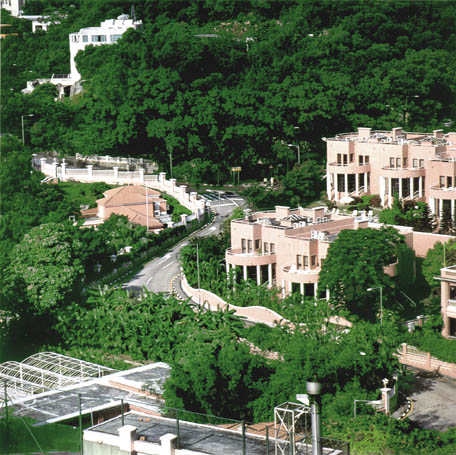 Government staff residences adjacent to the Governor's residence, in Colina da Penha (Penha Hill), Macao.
Photograph taken in 1998 by Amilcar Carvalho.
Government staff residences adjacent to the Governor's residence, in Colina da Penha (Penha Hill), Macao.
Photograph taken in 1998 by Amilcar Carvalho.
From the body of these Reports, in synthesis, I will also draw the conclusion that regarding the port area, town planning fought against the scourge of the port silting up and of typhoons and adverse weather conditions.
It was Dem~'etrio Cinatti, Chefe da Capitania dos Portos (Head Port Commander), who, in his 1881 Relat~'orio [...] (Written Report [...]) to the Governor gave a warning regarding the silting up at the port which destroyed access for vessels to the town, consequently placing the entire mercantile economy at risk. As for measuring this silting up process, below is an extract from the 1882 report by Constantino Jos~'e de Brito, director of Public Works in Macao:
"The accumulation of sand inside the harbour and the entrance is constant, and at the river bottom and near the harbour used for anchoring, the level is rising everyday, every hour, or rather every minute.
In April, 1880, the Capit~~ao do Porto [Harbour Captain] set out a series of tide marks alongside the bridge belonging to the steamship company who made trips between this port and Hong Kong. By June, 1881, the tide marks had risen by over five inches. The mud rose more than an inch from June to October, making it necessary to change the positioning of the tide marks. In reality it rose more than three inches, meaning that in less than three years the river bed had risen one and a half feet. Along the bridge for steamboats from Canton [Guangzhou], according to observations made by the same Harbour Captain, they found low tide water levels of one foot three inches, when just over a year ago they measured four feet."
Macao's port stopped being safe for navigation, whether faced with the phenomena of its rapid silting up, or any other situation with typhoons or inclement weather. One can evaluate the impact of this last problem in Dem~'etrio Cinatti's 1884 Relat~'orio [...1 (Written Report [...]):
"[...] due to the port's lack of shelter, five-thousand lives and three-thousand vessels have been lost, apart from the merchandise valued at more than five-hundred-thousand Patacas, during the six storms which occurred from 1871 to 1883.
Considering the value which sentiments can give to human life apart, in the sphere of wealth and business, men and intelligence, that is to say, the abilities of each individual are instruments of production which represent a certain value.
If to the loss of lives we add almost three-million Patacas, which is the cost of the vessels and merchandise lost, the outcome shows the absolute necessity for a shelter in the harbour to guarantee the safety or lives and property."
In 1883 it was necessary to intervene with utmost urgency and then work out the Ante projecto para o Melhoramento do Porto de Macau (A Draft for Improving the Port of Macao) in six months under Adolfo Loureiro. Unfortunately for reasons not dealt with in this article, the realisation of this preliminary plan dragged out over several decades with only some of the aspects set out being completed.
In summing up the Reports from what has briefly been said about the harbour area, one can conclude that Macao and its town planning was in a periodic battle against typhoons, fires and epidemics.
The safety and durability of buildings because of bad weather and typhoons, was of major concern, shown essentially in Reports of Public Works, whether dealing with unstable Chinese dwellings which did not last more than twelve to fifteen years, built with sub-standard materials and techniques, or with the infestations of termites in almost all wood used in Macao's buildings. However, they were of better quality than the Chinese dwellings and also, according to Augusto Tovar de Lemos in a Relat~'orio [...] (Written Report [...]) on the 1885 Servi~'cos de Sa~'ude de Macau e Timor (Health Service in Macao and Timor):
"The houses which the Macanese and Europeans live in are mainly of weak construction which makes the impact of typhoons stronger. They have one floor with rooms on the ground floor, called 'god~~oes' [lit.: 'go downs'] with little light or air for the most part, especially those underground. In their construction these buildings are somewhat heedless to scientific principles and to concepts of hygiene, as inside the partitions are very bad. They just have large living rooms, narrow bedrooms and cubicles."
Building safety should go hand in hand with improved planning and control of neighbourhoods in such a way as to minimise the cyclonic winds whenever they are felt.
One can appreciate the seriousness of the problem, the houses' weak resistance to cyclonic winds and bad weather, in view of the fact that only following the typhoon of the 22nd and 23rd of September 1874, the number of Chinese houses destroyed was one-thousand one-hundred and seventy-two "[...] not being possible to count the Chinese buildings which only suffered some damage to roofs, doors and windows, because more or less all the houses in Macao suffered similar damage. ”1
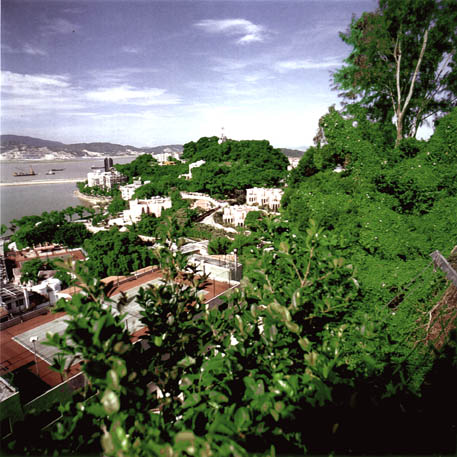 Panoramic view of the Barra promontory with the Governor's residence in the centre middle ground, Macao.
Photograph taken in 1998 by Amilcar Carvalho.
Panoramic view of the Barra promontory with the Governor's residence in the centre middle ground, Macao.
Photograph taken in 1998 by Amilcar Carvalho.
The scourge of fires was a direct consequence of the way adopted by the Chinese population of cramming and tightly enclosing their neighbourhoods, with thoroughfares strangled by all manner of obstacles.
In 1856, a "Boletim do Governo" ("Government's Bulletin") corrected the public notice of a few days earlier concerning a fire in the (Grand Bazaar): "In the last publication we gave 'as an Grande Bazar approximate calculation the number as six-hundred shops' destroyed by the typhoon of the 4th. We now know from a reliable source that the correct number of buildings completely burned down on that day reached four-hundred and twenty shops and four-hundred homes. ”2
It is unbelievable that after that fire and others which were on a smaller scale, this neighbourhood was rebuilt practically along the same lines as before. As an example, below are two mores cases exposing the seriousness of the situation:
21st of December 1864 -- "A huge fire in the night destroyed almost the entire village of Coloane, south of Taipa. The two-hundred and fifty homes, mainly of ola [palm leaves] were completely burned down though there were no victims. The village has been greatly diminished but it was found to be rebuilt by 17th of April, 1865."3
5th of February 1865 -- "A fire engulfed two-hundred shops in Horta da Mitra [Mitra's Vegetable-garden]."4
From the 1880's, combating the risk of fires ended as a consequence of the solution for replanning the suburbs, adopting wider and cleaner streets, as well as improving the devices for ready access for water pumps in fire areas and the creation of more careful regulations with regard to access to the springs and wells there.
"[...] it was from the 2nd of May, 1883 that the Regulamento do Servi~'co de Inc~^endios [Regulation for Fire Services] began, under the Portaria [Government Decree] no 39 of that year. However there were firemen and fire inspectors before that but this is the date regarded as the birth of the actual Corpo de Bombeiros [Fire Brigade] as celebrated there. Already in 1879, Major Quintanhilla hoped to submit a Regulamento [Bylaw] for the Governor's approval, according to Nota [Note] no 2 of August 1879, published in B. O. ["Boletim Oficial" -- "Official Bulletin"].'5
Epidemics and plagues which periodically decimated the Territory's population, especially among the Chinese, at a time when medicine throughout the world was just taking the first steps in investigating and experimenting with vaccinations, could only be dealt with through sanitation measures in the towns and countryside involved, related to which organised tree planting fulfilled a major role.
However the surprising fact is recorded by L~'ucio Augusto da Silva, Head of Macao's Health Service for nearly twenty years, of having achieved excellent results in the first attempts with vaccinations, referred to as "outstanding" in the Pref~'acio [Preface] to his Relat~'orio Sobre a Epidemia de Cholera-Morbus em Macau no Anno de 1862 (Written Report of the Cholera Epidemic in Macao in 1862). 6 During a serious epidemic in 1857, the head surgeon carried out the inoculation with variolico pus of three-hundred and eleven people, the majority of which, according to his account, had benign pockmarks and not one death was recorded.
In fighting against disease, several Chinese neighbourhoods were the target of successive operations so 'drastic' yet absolutely necessary, reaching the point of setting fire to and systematically demolishing these areas, followed by their urban infrastructure being rebuilt. The systematic drying out of the swamp areas in the level ground designed for farming were other measures which were applied to combat epidemics with good results. Here are some examples of what resulted:
Augusto Pereira Tovar de Lemos wrote on the demolition of around two-thousand tankas on the Sa Kong and San Kiu canals in the Relat~'orio do Servi~'co M~'edico da Prov~'incia de Macau e Timor (Written Report of the Medical Service of the Province of Macao and Timor), referring to the year 1885:
"The most effective works in improving sanitation carried out in 1885 were, without doubt, the eradication of the poor stilt houses along the Sa Kong and San Kiu canals, which acted as a pestilent shelter to a miserable and filthy society which, according to public opinion, mostly lived a lurid, debased and criminal life. It was a danger for public health and safety. There were perhaps more than two-thousand.
Entrusted by His Excellency the Governor, to thoroughly examine the conditions of those improvised and miserable dwellings, I gave my opinion in a brief Report where broadly speaking I was left with the sensation of horror which it all conjured up for a European who dared to enter those dirty, suspended cells (if one can use the term) where the most deplorable poverty exists. I reached the conclusion that the only solution was fire and the shovel. In proposing these therapeutic measures for their revision by the Very Worthy Government Council, I had the satisfaction to see that they were approved. There is now a great improvement in Macao with the disappearance of an enormous focal point of infection where, existing who knows ab initio, day by day would expand.
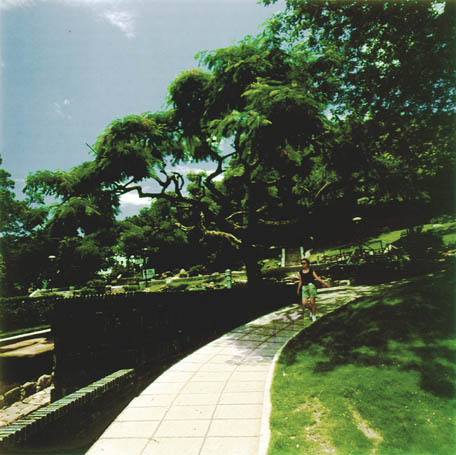 The Parque da Colina da Guia (Guia Hill Park), Macao.
Photograph taken in 1998 by Amilcar Carvalho.
The Parque da Colina da Guia (Guia Hill Park), Macao.
Photograph taken in 1998 by Amilcar Carvalho.
A period of three months was granted for evacuating the area. Confident in I do not know what, or devoted to their natural negligence, they allowed time to run out, or perhaps they did not believe in the carrying out of such an order, or had arranged a reaction. The truth is that not one China man decided to leave their filthy homes, suspended above ground even dirtier still. It was necessary for the Government to order its demolition, making use beforehand of the necessary police needed to keep the peace. It was thereby carried out by order of the Governor himself."7
A Despacho (Dispatch) from the Governor dated the 10th of May 1907, concerning the neighbourhood of Lou Tin Chin, ordered the Direc~'c~~ao das Obras P~'ublicas (Administration of Public Works) to carry out the Proposta no 184 (Proposal no 184) of the Junta da Sa~'ude (Health Commission), meaning:
"[...] the immediate evacuation of all inhabit-ants and the destruction by fire of entire areas with the aim of saving the lives of all these people and in this way preventing the spread of epidemics to the barracks in Flora where the European Infantry had their quarters, given that the health conditions were terrible along the earth filled bank which had already taken place in the said area."
In the Relat~'orio [...] (Written Report [...]) from the Administration of Public Works, of the 6th of May 1910, regarding the districts of San Kiu, Long Tin Chin, Seac Lu Tan, Tap Seac, São Miguel (St. Michael's), Volong and S~~ao L~'azaro (St. Lazarus'):
"Of these seven areas the second, third and fourth, old inferior villages or primitive towns, exclusively Chinese, unhealthy and dirty, were taken over and destroyed by fire, the last of them, Long Tin Chin, in 1907, already during my administration. Seac Lu Tau and Tap Seac were already levelled to the ground; Long Tin Chin is quite ahead in the land-fill process that will make the building ground two metres higher on average. The walls, ruins from the districts' old shacks, were entirely covered in earth. S~~ao L~'azaro [St. Lazarus'] and Volong are Macao's two modem districts, erected on top of the landfill made from the ruins and places in the old Volong Garden neighbourhood. They represent the first decisive step in extending the town beyond the Portas do Campo [Campo Gates], and its general sanitation.
Nothing substantial has to be changed in these neighbourhoods, as the plans show, all that is left is to extend them, connecting them with the new districts in the planning process. I should not lose the opportunity to send my admiration for my distinguished predecessor, Engineer Abreu Nunes, who, with as much perseverance as efficiency, knew how to set up the basis of the two beautiful neighbourhoods referred to which were later mentioned in Hong Kong as a real cure against infectious diseases. Those old neighbourhoods truly represented obvious and periodic focal points of epidemics: today one can say it is no longer there with only one case per year. It is what happened with Long Tin Chin, and Sa Kong and especially with Patane, the most active centre for the spread of plagues, whose sanitation I already had the honour to propose and even to initiate."
A little like a leg with gangrene which needs to be amputated if one wanted to save the body, these neighbourhoods also had to be burned and shovelled to the ground, then land-filled in order to save many, many thousands of inhabitants, particularly the Chinese, from epidemics. This policy's fairness must be understood, even in its extreme severity, given that establishing values of sanitation within a town guarantees the minimum conditions of quality of space, for the inhabitants' respectable, healthy lifestyle. Ultimately it was a case of life or death, unless you would fatalistically accept that hundreds of thousands of lives would be repeatedly wiped out by disease. Nevertheless, I believe that in order to understand this very policy completely, one cannot leave out the question for which I have no answer: was the rehousing of these settlements guaranteed or not, even if the original living conditions, in most cases, were of the most miserable hovels or homes on stilts?
One of the most important contributing factors of what I attribute to strategic town planning and sanitation of Macao, between 1880 and 1920, was undoubtedly the policy of methodical tree planting, adopted in the Territory from 1883, whether as a way of fighting erosion along the coastline which contributed to the harbour silting up, or as a very important factor in combating disease and improving the environmental conditions. Within the systematic vision in which town planning was understood, we can see some facets which characterise such a policy of tree planting and the creation and transformation of public gardens, which radically changed and improved the town's image.
~$S 2. TREE PLANTING IN MACAO
2.1. ON MACAO'S ARIDNESS
1655 - 1657-- Within these years Jacob de Keiser and Pierre de Goyer had already described Macao thus: "If looking from land, one sees not a single tree, nor any impediment along the way. Everything is open and barren. There are just two castles situated near the coast which are very well fortified and strongly protect the city against attacks.”8
2.2. THE EROSION OF THE ARID MOUNTAINS DAMAGES MACAO'S PORT
1882-- "At present the Chinese mountains, at least those in the areas near Macao, are all bald and barren, which is another cause which contributes to the disastrous effects this port is suffering.”9
2.3. THE TERRIBLE AND UNPLEASANT IMPRESSION ON ARRIVING IN MACAO
1883 --"It is a terrible and unpleasant impression that one finds on entering the radius and later the port when one sees the whiteness of the houses standing out among the small naked mountains, spotted with red gravel from place to place.”10
2.4. THE NECESSITY FOR SYSTEMATIC TREE PLANTING
1870 -- Writing on tree planting, Dr. L~'ucio Augusto da Silva, in his Relat~'orio [...] (Written Report [...]) on Macao's Health Service, referring to that year, said:
"The healthy influence of groves of trees in the large centres of population is generally accepted today. The small peninsula of Macao, arid and surrounded by barren mountains, needs systematic tree planting, not only in the city, but also along the coastline and on the peaks of some hills. There are few groves of trees in the city, most are around convents and private houses. Some trees were planted during the governing of [Gon~'calves Cardoso] and Coelho de Amaral and some of them died, others were uprooted. Among the first ones, a beautiful poplar grove stands out to the far east of Praia Grande [Praya Grande], made up of thirty very beautiful trees, which circum-scribe along the seashore and the public garden and border the street until the Jardim de S~~ao Francisco [St. Francis's Garden]. Nine of these leafy trees in the front, apart from three others which remained in the area behind within the garden were cut down in order to build a house for the new Clube Militar [Military Club]! I will not qualify the fact that this made the deepest impression on many people. Another seven trees were also felled on a property adjoining the garrison on the infantry battalion.”11
2.5. THE C~'ODIGO DAS POSTURAS
DO LEAL SENADO (CODE OF MUNICIPAL ORDINANCES FROM THE MUNICIPAL COUNCIL) AND THE CONSERVATION OF TREES
1871 -- "On the 21st day of the month of November of 1871 in Macao, in the Assembly Hall, the Leal Senado [Municipal Council] of the town council in regular session;
-- Considering the usefulness of compiling all the measures previously published into one;
-- Considering the need to review these measures, adopting them to law and current laws in use, and using the rights conferred on them by Artigo [Article] 120 of the Administration codes;
-- On seeing the precepts of the corresponding legislation, etc.; agree on the following:
CHAPTER I
PROVISIONS RELATED TO THE CONSERVATION OF TREES, PAVEMENTS AND ANYTHING PERTAINING TO PUBLIC THOROUGHFARES
SECTION 1
PROVISIONS RELATED TO THE CONSERVATION OF TREES
Article 1 -- It is forbidden to attach, or fasten anything to the trees which are in a public place, or climb them, apart from this if no immediate damage is made, punishable under the following article; under the penalty of a $1 ['Macao Dollar',i. e., Pataca] fine.
Article 2 -- It is equally forbidden to beat with a stick, throw stones, sticks, or similar objects, break any stem or shoot,: under the penalty of a $2 fine.
Article 3 -- Whoever cuts or uproots any of these trees incurs 4 times the penalty ordered in the previous Article, except when provided with a licence not fulfilling all or part of the conditions granted them.”12
2.6. TREE PLANTING DISTURBING THE CHINESE CEMETERIES
1877 -- Throughout a period of two years from this date a good number of much valued trees, '~'Arvores de Pagode' ('Pagoda Trees') or '[~'Arvores de S~~ao Jos~'e ('St. Joseph's') Trees]' were success-fully planted. However, only some of the places are mentioned which still display some of the most beautiful examples: twenty-two trees were planted along Rua do Tanque do Mainato (Mainato Pond Street), one-hundred and seven on Rua da Praia Grande (Praya Grande Street), twenty-seven along Estrada de S~~ao Francisco (St. Francis Road), eighty-six on Rua de Mong Há (Mong Ha Street) and thirteen on Rua do Lilau (Lilau Street) e Barra (Barra).
1882--"Five-hundred and fifty trees of different varieties were planted over the past year in different sectors of the town and in the Flora [Garden] area, the majority of which grew. It is not possible to plant many more trees each year without difficulty. Being the dry season at the correct time for planting, it is necessary to water the trees daily until the arrival of the rainy season. The costs involved in sowing pine trees on Tap Seac hill, alongside Cemit~'erio de S~~ao Miguel [St. Michael's Cemetery], the hill above Hospital de S~~ao Janu~'ario [St. January's Hospital] and the one behind Flora were wasted. Because the hills and mountains in Macao are turned into cemeteries for the Chinese, and they are bothered by the idea that the pine trees' roots could disturb the peace of their ancestors, they tried to destroy the sowing. Those not uprooted by the Chinese were destroyed by cattle, although some did grow.
It is difficult to succeed with tree planting in Macao, as long as strict precautions are not taken; it would be proper that the police and the municipal inspectors have instructions to prevent the destruction of trees. Often they are stolen from the less visited areas, when not the very trunks, at least the supports which have to accompany trees at first so they are not blown over by strong winds.
The money spent on tree planting in the past year was one-hundred and sixty Patacas and twenty five Avos, not including the seventy Patacas still to come from the conservation budget for planting willow trees along the roadways, in front of Ilha Verde [Green Island], as a departure point for the future embankment [of reclaimed land].”13
1882 -- "Just after His Excellency graciously informed me that the dredge had been ordered, I have ordered the commencement of works on the Tarrafeiro site and, in front of Ilha Verde [Green Island], the planting of willows in perpendicular rows to the border, ending with others parallel, as that area lends itself most to this. ”14
1882- "In my Report I mentioned (relating to the year 1870) I wrote further:
"The healthy influence of groves of trees in the large centres of population is generally accepted today. The small peninsula of Macao, arid and surrounded by barren mountains, needs systematic tree planting, not only in the city, but also along the coastline and on the peaks of some hills. There are few groves of trees in the city, most are around convents and private houses. Some trees were planted during the governing of Gon~'calves Cardoso and Coelho do Amaral and some of them died, others were uprooted. Among the first ones, a beautiful poplar grove stands out to the far east of Praia Grande [Praya Grande], made up of thirty very beautiful trees, which circumscribe along the seashore and the public garden and border the street until the Jardim de S~~ao Francisco [St. Francis' Garden]. Nine of these leafy trees in the front, apart from three others which remained in the area behind within the Garden were cut down!
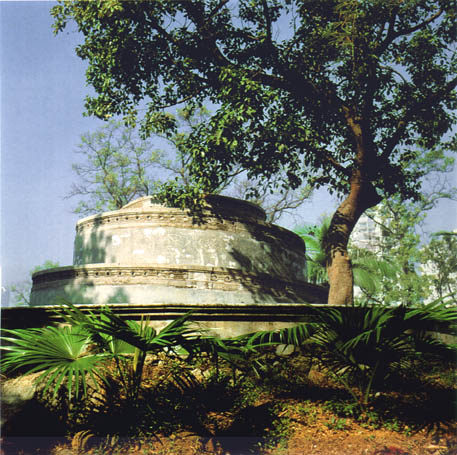 The spiralling ramp leading to the viewing platform which crowns the Jardim da Montanha Russa (Russian Mountain Garden), Macao.
Photograph taken in 1998 by Ho-sang Wong.
The spiralling ramp leading to the viewing platform which crowns the Jardim da Montanha Russa (Russian Mountain Garden), Macao.
Photograph taken in 1998 by Ho-sang Wong.
Care was taken in 1882 that trees were planted, as they did almost every year; but unfortunately always on a small scale and without the protection they needed.
For the first time they dedicated themselves to seed plots of pines, with pines from Portugal, on some hillsides and mountains, and five-hundred and fifty trees were planted in different parts of town, of which not all grew for reasons which the actual director of public works refers to in his Report. These reasons, the difficulty in watering every day until the rainy season, small trees and the stakes which support them being stolen in less crowded places and their destruction by the Chinese and by cattle, can be overcome with the use of indispensable precautions and allowing the necessary amount for expenses which this will incur. The importance of the one-hundred and sixty Patacas spent in the year 1882 with the planting of trees and seedlings, apart from the seventy Patacas with the willows in front of Ilha Verde [Green Island], is insignificant for the objective of so much advantage to the public. It is necessary to attend not only to the planting of trees, but also to their conservation against the destruction which is caused by cattle and people. The effect torrential rains and typhoons have is no small thing either."15
2.7. TREE PLANTING ON TAIPA AND COLOANE ISLANDS
1882- "Distinguished Sir, I have the honour to participate in Your Lordship's idea which was warmly received by the Commission, as put for-ward in your Of~'icio [Bill] no 419 of the 4th of this month, which deals with the tree planting of certain sites; and convinced of the benefits to be gained from seed plots and planting trees for felling, the Commission offers to begin the first work projects. Taking into account the advice given by experts, places have been indicated where the best ground is for seed plots, and the sites which will be used for the first seed plots.
In the village of Taipa, two small plans have been chosen, with deeper earth which is protected from the northerly and easterly winds. Ilha de S~~ao Joao [St. John's Island] has a great expanse of land which I have not yet approved as I have not yet worked out the way to proceed with the demands of this important job. The Island's tipu has already given me his full co-operation, a most valuable aid, as he will be in charge of the works and their fiscal control.
In Coloane Island there are several places where preferably one should make the seed plots and they are the sites near Thin Hao Mio Pagoda; Seac Pai Van valley and the Koho slopes. Of all these designated sites, only those in Taipa and Coloane villages need a small annual budget for overseeing the place and taking care of the trees.
The Municipal Commission will soon vote for the budget they consider necessary for acquiring seedlings and trees for the planting.
It is with great pleasure that I communicate to your Excellency the Municipal Commission's decision, in concordance with your Excellency's wishes.
This is what beholds me to say in reply to your Excellency's Bill."16
1882 - "Also in regard to the tree planting of Taipa Island, and secondly the participation of a respective commander, the tracts of land which will be planted have already been marked out."17
2.8. AN EXAMPLE OF TREE PLANTING IN THE NEIGHBOURING COLONY OF HONG KONG
1882 -"In the neighbouring Colony of Hong Kong, not only do they take great care with the planting of trees along the streets, squares and roads, but they have tried to create forests in uncultivated and wild areas. According to accounts from there, they have planted two-hundred and eleven-thousand and fifteen trees on the Island. Of the indigenous pine, Pinus Sinensis, two-hundred and six-thousand three-hundred and sixty-five were planted, sixty-thousand five-hundred and sixty-five in seed plots on sites where they will remain in situ, and other transplantings; apart from one-thousand five-hundred and thirty-seven trees of different varieties of eucalyptus and other plants. The work involved in planting trees continued in 1881, being pines, with one or other system, numbering seven-hundred and fifty-one-thousand and fifty-eight and of eucalyptus four-thousand three-hundred and forty-seven. I learned there, with the experience of some years, that although the pines were very early and did well in dropping seeds where they should, through this system these trees did not sprout in the first years as vigorously as those which were trans-planted from the nurseries; and that the eucalyptus grew up perfectly among the pine trees, not happening as much when they were shaded by other trees.
Apart from the trees which generally take root, it would be beneficial for Pinus Sinensis seed plots to be sown in Macao, not only for on the mountains and hillsides where they did last year and where they were destroyed by the Chinese, but in other areas too, arranging things in a way that they can grow.
Nurseries should be set up fore these trees for the eucalyptus, choosing a convenient site for this on one of the Islands of Taipa, S~~ao Jo~~ao [St. John's] or Coloane, which from there will be transplanted onto the Macao peninsula, especially Eucalyptusg lobalus, this beautiful tree which apart from its attributes, grows quickly and has good wood."18
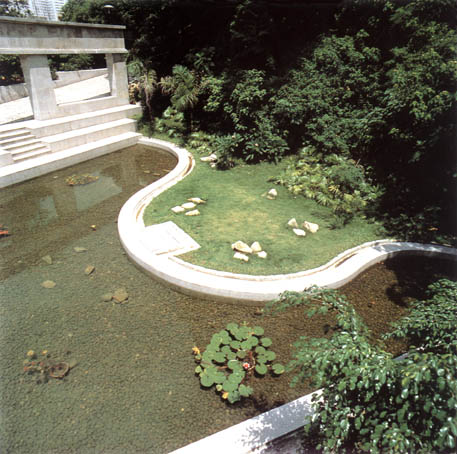 The Parque da Colina de Mong H~'a (Mong Ha Hill Park), Macao.
Photograph taken 1998 by Amílcar Carvalho.
The Parque da Colina de Mong H~'a (Mong Ha Hill Park), Macao.
Photograph taken 1998 by Amílcar Carvalho.
2.9. DEFINITION OF THE CRITERIA FOR A POLICY OF TREE PLANTING
1883 - "The last matter which the Commission dealt with was the tree planting of the town and nearby areas. It is unnecessary to exaggerate the advantages of tree planting as they are so obvious that no-one today would dare to disagree.
There are three main reasons for tree planting; purifying the atmosphere, the drainage of excess water from the topsoil, and the balancing of meteorological conditions. Another no less deserving consideration is the beautifying of cities and the comfort trees give traffic during the hot part of the day.
Two types of tree planting should be considered. The first type should be established within the town, in gardens and along streets, the second should cover the mountains nearby making then lose the arid and barren appearance they have today.
As far as tree planting in the inner city streets is concerned, trees should be chosen which are fast growing, with bushy tops and deep roots which do not spread out too much horizontally so that they do not damage the foundations of the town's buildings. In gardens, this last point is imperative, and more than that they should be concerned with the species and beauty of the trees, choosing exotic plants which give shade with good foliage and that please with their diversity.
For along the streets, the different varieties of ~'Arvores de Pagode [Pagoda Trees] meet all these tree planting requirements.
Mountainsides need more hardy trees to with-stand typhoons more effectively, so plant pine trees on the peaks and other firs which can take poor soil and use Ficus and well pruned Marguzeiras [Port.] {sic} on the hillsides.
On more established ground there would be the advantage of organising wide plantations of mulberry trees, whose leaves provide food for the precious bombyx mori [silk worms], the insect which produces the primary material for a very lucrative industry. Macao's climate is admirably suited to extensive silk worm cultivation and from the moment in which vast plantations of mulberry trees have established themselves both on Macao, Taipa and Coloane, it will follow that they will produce in abundance."19
2.10. REPORT CONCERNING THE TREE PLANTING OF MACAO BY THE AGRONOMIST TANCREDO CALDEIRA DA CASAL RIBEIRO
1883-1884 - "Having placed this branch of the service under the Administration of Obras P~'ublicas [Public Works] some time ago, in the estimated costs of the department, the budget for these works has been allocated, a paltry and insufficient budget, combining that of public gardens and other major undertakings. Under the circumstances, to avoid accounting difficulties, the costs will continue to be met through this department, being the weekly payroll processed by the system applied there. The lack of budget set aside for tree planting does not allow the development deserved by such an important branch of work, because in Macao it is not enough to plant trees along the streets, it is also urgent to plant up the mountains where it is at present arid and barren and gives such an ugly view to the traveller who arrives in Macao. It is a very sad and unpleasant impression that one receives on entering the area and later within the harbour when one sees the whiteness of houses standing out among the small, bare mountains, intermittently dotted with red gravel.
This was the initial impression I had of the town the first time I arrived and I was pleased when I was placed in charge of this project, to be able to contribute within the limits of my capacities, to beautifying these mountains which covered with vegetation could transform this Colony into truly the Cintra [Sintra] of Southern China.
If the comparison is exaggerated in appraising the beautiful sights, it is because these privileged areas cannot be copied or plagiarised, and it is not circumstantial or by accident that Macao can be a refuge during the hot season for the rich inhabitants of Hong Kong and Canton [Guangzhou], for there are no amenities or fresh air like there are here.
To carry out this transformation it is necessary to carefully weigh up the soil and climate conditions, and in order to be able to evaluate correctly these aspects, the practical results sent by His Excellency from Hong Kong, whose soil is almost the same as that in Macao, and whose climate, though more extreme with regard to the cold and heat, closely resembles this city a great deal, will help.
What has been carried out in terms of tree planting in the neighbouring Colony is truly a marvel, as it is always the fruit of tenacity and intelligence; though there was a lot admire, I had a lot to learn during the days spent with Mr. Ford, Director of the Botanical Gardens and Chief of. Works in tree planting, from whom I heard the valuable advice which his many years of experience had given him.
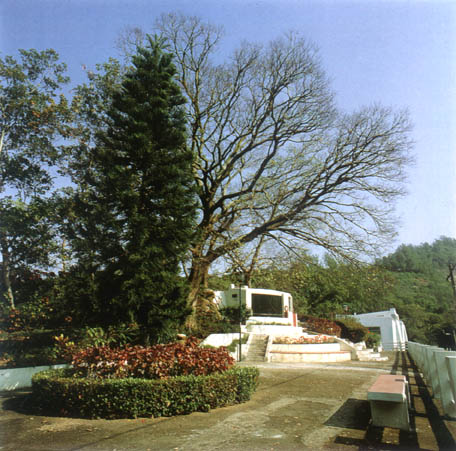 The Jardim Municipal (Municipal Garden), Taipa Island.
Photograph taken in 1998 by Ho-sang Wong.
The Jardim Municipal (Municipal Garden), Taipa Island.
Photograph taken in 1998 by Ho-sang Wong.
Twenty years ago the mountains around Hong Kong were barren and arid, but today they are covered in pines and will soon encompass the heights of Victoria Peak. The system which has been followed there for the town is not that of seed plots but of transplanting, which is carried out after a year in the nurseries, when the plants measure about 35 cm from their base to their stem. The time allocated for this type of work is six months each year, counting January until the end of June, always choosing a rainy period to carry it out, with the aim of saving the enormous expense of watering, imperative during the first phases of transplanting.
The British Government considered it more convenient, and less costly, to not set up the Pinus Sinensis nurseries at their own expense, which means essentially almost exclusively paid workers, preferring rather to contract the Chinese who receive the seeds with the obligation to supply, at a certain time, several thousand plants, which are paid for at the rate of nine Patacas per thousand. The average percentage of plants dying is 5% which in reality is quite a high percentage.
Nevertheless the season was early and in mid-July the nursery owners in Hong Kong were hired to provide five-thousand pine trees to try as an experiment here which has given good results elsewhere. The costs were not wasted because they came at such a good time and at an opportune moment that not only did most of them take root, but have sprouted up until today with admirable vigour.
Taking advantage of the opportunity with the planting period having finished for that year, we obtained the pines needed from the Chinese at a good price, ending up at a thousand for five and a half Patacas. The costs involved in packing and transporting them from Aberdeen even in steam boats and from there to Macao is what put up the price to nine réis per tree approximately.
The first step was to chose the site in which to carry out the experiment, one which was not too barren that it would kill the plants, nor too rich that it would hinder the real result of the experiment for it was necessary to judge the system's merits not the soil's fertility.
It is worth noting that soil in Macao's peninsula, with the exception of the cultivated plains, is poor and lacking in nutritive elements, being the ruins of the mountains formed by granite which emerge there in blackened, rugged rock which is intermingled with a earth make up of rough gravel, lacking in mineral substances and extremely poor in organic compost material. It was very difficult finding fertile soil as it was arid and infertile everywhere one looked.
I decided to carry out an experiment at the beginning of the hillside on Colina da Guia [Guia Hill], in the area from Victoria Road up until the first stretch of road which zigzags up until the fort. The south easterly exposure of this area is also favourable because in this way one had less to fear of the relentless easterlies which sometimes violently lashed at the trees and which the newly planted trees would certainly suffer from.
On choosing the site, holes were dug a metre apart with a width and depth of 40 cm, leaving them open for a few days for the earth to expand them. Preparation began with the plants being delivered in loads of five-hundred pines in each and planting finished in the normal way if no such other kind of work such a hoeing was needed, given that the weather was quite hot with the joint objective of destroying the weeds surrounding the stems and to prevent the earth drying up, which was what was feared when prolonged drought was coupled with high temperatures. The season was early, the transport from Aberdeen to Macao was slow therefore the plants suffered, and firstly the work's urgency was a cause of foregoing the recommendations which they had made regarding the way to plant; but nevertheless, the bad conditions under which the work was carried out were compensated for by the rain which fell during the two months after planting, almost without stopping, making the loss of trees minimal, as no more than one hundred and ten pines died, that was 3.5%, which was below the percentage in Hong Kong.
The good fortune from this first attempt encouraged working on a larger scale, and for this reason I initiated the building of a nursery where, whether for seeds or stakes, one could obtain the plants required. The work began badly as it was interrupted by a more urgent task, which was repairing the damage from the typhoon which blew strongly spreading the usual damage, but which lashed at the trees in such a way that it left them in a sorry state.
According to the authorities, no other typhoon, not even the one in 1874, had caused the extent of damage to the trees. Before anything else, It was necessary to repair the damage beginning with those trees which were lying on the ground and which, thanks to the hardy vitality of the species (Ficus religiosus) took root again, giving almost the same appearance today as those which were simply defoliated, and those which were pruned secularly branched out with amazing vigour.
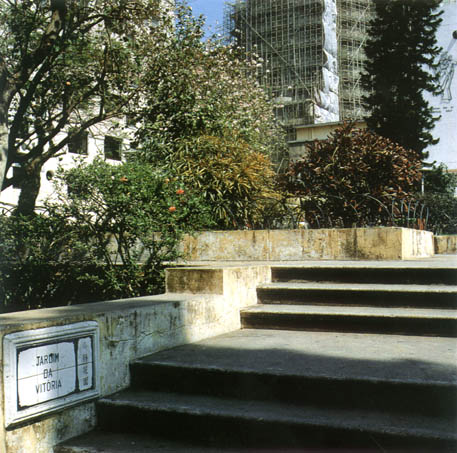 The Jardim da Vit~'oria (Victoria Garden), Macao.
Photograph taken in 1998 by Ho-sang Wong.
The Jardim da Vit~'oria (Victoria Garden), Macao.
Photograph taken in 1998 by Ho-sang Wong.
The main cause of tree damage was not so much the force of the winds as the little resistance the plants could give because of the enormous length of their branches. The repair job over, I moved on quickly to building the nurseries, for which I had chosen a site adjoining the Jardim da Flora [Flora Gardens], in an area enclosed to the south by a wall of the same garden and to the north by the wall above which the water pipes ran along the roadside.
It was a sloping piece of land full of ruts, making it hard work to level out and arranged in a way for the purpose it had been set aside for. The nursery was divided into two parts, one for reproducing with grafting and the other for seedlings, separated from each other by a 40 m wide walkway surrounded by ailantus, grevilias, and other species of trees which broke the monotony of the nursery and made it a very delightful place.
Upon finishing the task of levelling out, I ordered a trench of 70 cm, not only to turn over the earth, but also to eliminate the roots of the enormous quantity of weeds and in particular the couch-grass which cut across the soil in every direction forming a very tight knot which hardly allowed any other plant to take on nearby.
The soil quality was bad in its physical constitution and worse still due to the poor quality of its chemical composition. It was the product of the slow breaking up of granites whereby some appeared like veritable leptynite and from which the aluminium silicates were entrained into fine particles for the cultivated plains, leaving the quartz as the heaviest nutrient to form almost all the top soil. I urged, to correct it and compensate for the lack of nitrogen, phosphorus and organic material and in order to do this, made use of the manure from the horses in the cavalry and from the oxen from the C~^amara Municipal [City Council] and Reparti~'c~~ao Municipal de Obras P~'ublicas [Provincial Department Public Works]. However, as these manures were not fermented but were taken straight from the stables to the site and worked into the soil, it was necessary to collect old rubbish deposits which had been buried in holes in the ground behind the cemetery, and in this way it was possible to obtain the necessary manure mass.
It will be necessary to allow for this method next year, in order to avoid the embarrassment caused this year, and for this it is sufficient to make a manure pile with dozens of rubbish carts which have already had stones thrown into, mixing them up with one-hundred loads of animal manure.
The higher part of the nursery is set aside for seedlings of Pinus Sinensis, Cipressus Japonica, Aleuite triloba, Ailanthus glandulosa, Ponciana pulcherrima, L. and so on for the planting of some Laurus camphora L. and Ficus elastica Roxb.
Of the species reproducing on stakes which we obtained in May, on a scale it was Morus alba which produced more than three-thousand plants, amounting to between three-hundred and four-hundred of other species. As far as the seed plots and production went, the most prolific were Pinus Sinensis which germinated over two hundred-thousand plants.
Not counting the pines, the nursery could provide nearly six-thousand plants per year. Counting the tree planting projects, it deserves the watchful attention of Your Excellency, which apart from the waiting, can be assured that next year the tree planting plans along the streets will be completed and further on the covering of the mountains, which also received a far greater incentive than past years and whose results we will give in the following brief Report.
As an economic measure, convicts were requisitioned for making the holes in the streets and on the mountainsides, a job which they began to work on at the beginning of October, and which had the advantage of leaving the holes in contact with the atmosphere for a few months. This change was not enough to modify the terrible soil quality, and because of this it was necessary to resort to refuse, which was abundantly used in fertilising the holes.
The planting of stakes began at the beginning of January, and almost all of them came from the pruning being carried out at the same time on the old trees along the streets and the English Cemetery. These last trees were kindly placed at our disposition by the Honour-able English Consul, Mr. Murray, who obliged us by allowing the cutting of any branches we required.
Approximately two-thousand three-hundred stakes were prepared, almost all of Ficus religiosus, repusa and retusa, and thanks to the manuring, the depth to which they were buried and the conscientious care they received, two-thousand grew which show a superior growth in foliage than stakes three years old generally show.
As the nursery seedlings gave more than enough seeds, especially of Pinus Sinensis, all were planted in the mountains and sown in small holes. Four loucanes, who had given good service, were appointed to take care of the seed plots, protect them from cattle destroying them, and at the same time to prevent the trees on stakes being vandalised by the Chinese."20
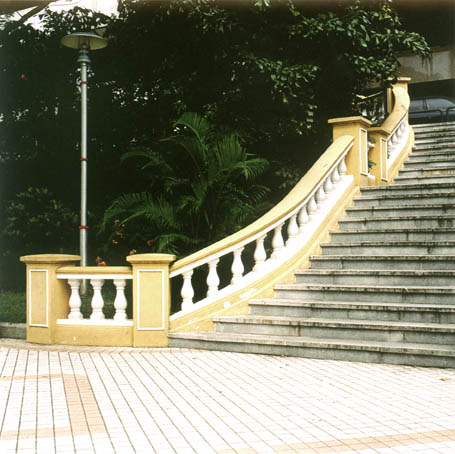 A staircase in Jardim de Vasco da Gama (Vasco da Gama Garden),
Macao. Photograph taken in 1998 by Amilcar Carvalho.
A staircase in Jardim de Vasco da Gama (Vasco da Gama Garden),
Macao. Photograph taken in 1998 by Amilcar Carvalho.
1885 - "A mountain range which stretches and borders the city to the east. [...] The hillsides of these mountains with stunted growth on some spots, others barren, showing the granite soil in several areas, presented a sad and desolate picture a short time ago, an appearance which it is actually starting to lose; and will be beautiful forests later on, thanks to the care and interest which Your Excellency, Governor Rosa, has taken in beautifying and improving Macao with extensive tree planting. [...]
The peninsula is enclosed to the southwest by a huge mountain, on which plateau there is a ruined monastery. Monte da Penha [lit.: Penha Mountain, or Penha Hill]. The hillside which faces the city is covered in trees, producing a delightful view; the side facing the sea drops down in crags until the Forte de S~~ao Tiago da Barra [Fort of St. James at the Bar]. The rest of the city is almost completely flat."21
1885 - "The benefits from tree planting, the very important role it plays in public sanitation is well known and so obvious that I will refrain from dwelling on what is already publicly acknowledged. Suffice to say that the beneficial effects of the cultivation enterprise by His Excellency the Governor should soon be felt.
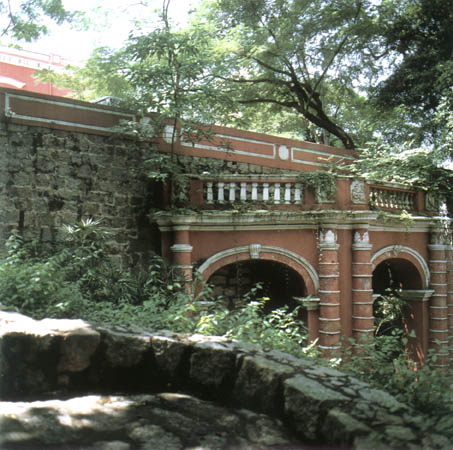 Upper part of the fountain pavilion in the Jardim de S~~ao Francisco (St. Francis' Garden), Macao.
Photograph taken in 1998 by Amilcar Carvalho.
Upper part of the fountain pavilion in the Jardim de S~~ao Francisco (St. Francis' Garden), Macao.
Photograph taken in 1998 by Amilcar Carvalho.
The grove of trees, taken from a nursery in the Flora area and well cared for, were transplanted to several places around the town and especially along the mountain range to the east, surrounding the large lake named Flora, is already quite beautiful and vibrant. The cultivation is on a large scale, and within five or six years will beautify the town. Those mountains, which due to their barrenness, granite soil and craggy rocks, give a sad impression to the traveller, and by their very nature are more suitable for dynamiting, being more appropriate as a supply of rocks for building houses, rather than feeding its core with vegetable matter and transforming it into lovely forests. Foreigners visiting Macao will be given a more pleasant impression.
According to what can be seen in the report made by the Agronomist, Your Excellency Mr. Tancredo do Casal Ribeiro, the following tree varieties were planted between July 1883 and March 1884:
Pinus Sinensis
lang=EN-US style='font-size:10.5pt;mso-bidi-font-size:12.0pt'>Pinus
Sinensis
lang=EN-US style='font-size:10.5pt;mso-bidi-font-size:12.0pt;font-family:
宋体;mso-fareast-font-family:黑体'>
|
lang=EN-US style='font-size:10.5pt;mso-bidi-font-size:12.0pt'>20,000
peduncles
|
lang=EN-US style='font-size:10.5pt;mso-bidi-font-size:12.0pt'>Cipressus
Japonica
lang=EN-US style='font-size:10.5pt;mso-bidi-font-size:12.0pt;font-family:
宋体;mso-fareast-font-family:黑体'>
|
lang=EN-US style='font-size:10.5pt;mso-bidi-font-size:12.0pt'>
style="mso-spacerun: yes"> 300 peduncles
lang=EN-US style='font-size:10.5pt;mso-bidi-font-size:12.0pt;font-family:
宋体;mso-fareast-font-family:黑体'>
|
lang=EN-US style='font-size:10.5pt;mso-bidi-font-size:12.0pt'>Aleurites
triloba
lang=EN-US style='font-size:10.5pt;mso-bidi-font-size:12.0pt;font-family:
宋体;mso-fareast-font-family:黑体'>
|
lang=EN-US style='font-size:10.5pt;mso-bidi-font-size:12.0pt'>
style="mso-spacerun: yes"> 300 peduncles
lang=EN-US style='font-size:10.5pt;mso-bidi-font-size:12.0pt;font-family:
宋体;mso-fareast-font-family:黑体'>
|
lang=EN-US style='font-size:10.5pt;mso-bidi-font-size:12.0pt'>Ailanthus
glandulosa
lang=EN-US style='font-size:10.5pt;mso-bidi-font-size:12.0pt;font-family:
宋体;mso-fareast-font-family:黑体'>
|
lang=EN-US style='font-size:10.5pt;mso-bidi-font-size:12.0pt'>
style="mso-spacerun: yes"> 300 peduncles
lang=EN-US style='font-size:10.5pt;mso-bidi-font-size:12.0pt;font-family:
宋体;mso-fareast-font-family:黑体'>
|
lang=EN-US style='font-size:10.5pt;mso-bidi-font-size:12.0pt'>Ponciana
pulcherrima L.
|
lang=EN-US style='font-size:10.5pt;mso-bidi-font-size:12.0pt'>
style="mso-spacerun: yes"> 300 peduncles
lang=EN-US style='font-size:10.5pt;mso-bidi-font-size:12.0pt;font-family:
宋体;mso-fareast-font-family:黑体'>
|
lang=EN-US style='font-size:10.5pt;mso-bidi-font-size:12.0pt'>Laurus camphora L.
lang=EN-US style='font-size:10.5pt;mso-bidi-font-size:12.0pt;font-family:
宋体;mso-fareast-font-family:黑体'>
|
lang=EN-US style='font-size:10.5pt;mso-bidi-font-size:12.0pt'>
style="mso-spacerun: yes"> 300 peduncles
lang=EN-US style='font-size:10.5pt;mso-bidi-font-size:12.0pt;font-family:
宋体;mso-fareast-font-family:黑体'>
|
lang=EN-US style='font-size:10.5pt;mso-bidi-font-size:12.0pt'>Ficus elastica
Roxb.
lang=EN-US style='font-size:10.5pt;mso-bidi-font-size:12.0pt;font-family:
宋体;mso-fareast-font-family:黑体'>
|
lang=EN-US style='font-size:10.5pt;mso-bidi-font-size:12.0pt'>
style="mso-spacerun: yes"> 300 peduncles
lang=EN-US style='font-size:10.5pt;mso-bidi-font-size:12.0pt;font-family:
宋体;mso-fareast-font-family:黑体'>
|
lang=EN-US style='font-size:10.5pt;mso-bidi-font-size:12.0pt'>Erytrina
style="mso-spacerun:
yes">
|
lang=EN-US style='font-size:10.5pt;mso-bidi-font-size:12.0pt'>
style="mso-spacerun: yes"> 300 peduncles
lang=EN-US style='font-size:10.5pt;mso-bidi-font-size:12.0pt;font-family:
宋体;mso-fareast-font-family:黑体'>
|
lang=EN-US style='font-size:10.5pt;mso-bidi-font-size:12.0pt'>Morus alba
style="mso-spacerun:
yes">
|
lang=EN-US style='font-size:10.5pt;mso-bidi-font-size:12.0pt'>
style="mso-spacerun: yes"> 3,000 peduncles
lang=EN-US style='font-size:10.5pt;mso-bidi-font-size:12.0pt;font-family:
宋体;mso-fareast-font-family:黑体'>
|
lang=EN-US style='font-size:10.5pt;mso-bidi-font-size:12.0pt'>
Already after this, a further several thousand have been laid in and actually a lot of work continues on the same project."22
1885 - "It is not my intention to show here the several advantages of tree planting. How much the town of Macao will benefit, with the arid, barren mountains of not long ago, now appearing covered in a luxuriant green carpet, make the beneficial results evident. The level of cleanliness, healthiness and beauty of the town has reached, through properly developed and spread out tree planting has trans-formed the burning hot earth into a pleasant and cheerful forest of trees. These advantages are well known and everywhere and everyone recommends tree planting as one of the most efficient means to achieve healthy soil and atmospheric conditions.
It was Chevreul who recognised and proved the great influence trees had on the land's well being with their growth and development. They take un-suitable substances from the earth which can be the short and long term causes of infection.
On the other hand Scoutetten's experiments clearly prove that plants exhale large quantities of ozone during the day, an important gas appropriate for the combustion of organic wastes from decomposing masses and is extraordinarily anti-bacterial.
And Pasteur, a highly respected and admired man everywhere, when he said: "il est au pouvoir de l'homme de faire dispara~^itre les maladies parasitaires", he presented tree planting and urban plantings in streets as one of the main principles to achieve this end. For these reasons, and to see to the beautifying of the country and the comfort of its inhabitants, who will easily find shade during excessive heat, which is frequent here, this indication supports planting a greater number of trees, as can be seen on the map which comes with this Report, where all the planted areas are shown, and which have developed over the last three years.
It is worth noting that apart from these, many others, simply for their beauty, were placed in different gardens and several thousand pine trees which were seeded on all the mountains around Macao, are in a satisfactory stage of development today, and will soon eclipse the barren appearance of these granite based areas.
The past year, to which I should refer specifically, five-thousand three-hundred and forty-four trees were planted in various places, and in the nursery at Flora [Garden], whose seeds were con-signed to producing, by way of stakes and other different seedlings, the following trees which are actually available to be planted in the future:
Melia azederack L
lang=EN-US style='font-size:10.5pt;mso-bidi-font-size:12.0pt'>Melia azederack L.
lang=EN-US style='font-size:10.5pt;mso-bidi-font-size:12.0pt;font-family:
宋体;mso-fareast-font-family:黑体'>
|
lang=EN-US style='font-size:10.5pt;mso-bidi-font-size:12.0pt'>in 56 seed beds
5,550
|
lang=EN-US style='font-size:10.5pt;mso-bidi-font-size:12.0pt'>Ficus retusa
L.
|
lang=EN-US style='font-size:10.5pt;mso-bidi-font-size:12.0pt'>in 12 seed beds
2,588
|
lang=EN-US style='font-size:10.5pt;mso-bidi-font-size:12.0pt'>Ponciana
pulcherrima L.
|
lang=EN-US style='font-size:10.5pt;mso-bidi-font-size:12.0pt'>in 10 seed beds
0,476
|
lang=EN-US style='font-size:10.5pt;mso-bidi-font-size:12.0pt'>Ficus nervosa ROTH
lang=EN-US style='font-size:10.5pt;mso-bidi-font-size:12.0pt;font-family:
宋体;mso-fareast-font-family:黑体'>
|
lang=EN-US style='font-size:10.5pt;mso-bidi-font-size:12.0pt'>in
style="mso-spacerun: yes"> 2 seed beds 0,090
|
lang=EN-US style='font-size:10.5pt;mso-bidi-font-size:12.0pt'>Wax tree*
style="mso-spacerun: yes">
lang=EN-US style='font-size:10.5pt;mso-bidi-font-size:12.0pt;font-family:
宋体;mso-fareast-font-family:黑体'>
|
lang=EN-US style='font-size:10.5pt;mso-bidi-font-size:12.0pt'>in
style="mso-spacerun: yes"> 1 seed bed 0,104
|
lang=EN-US style='font-size:10.5pt;mso-bidi-font-size:12.0pt'>Erythrina
Indica Lamk
lang=EN-US style='font-size:10.5pt;mso-bidi-font-size:12.0pt;font-family:
宋体;mso-fareast-font-family:黑体'>
|
lang=EN-US style='font-size:10.5pt;mso-bidi-font-size:12.0pt'>in
style="mso-spacerun: yes"> 1 seed bed
style="mso-spacerun: yes"> 0,105
style='font-size:10.5pt;mso-bidi-font-size:12.0pt;font-family:宋体;mso-fareast-font-family:
黑体'>
|
lang=EN-US style='font-size:10.5pt;mso-bidi-font-size:12.0pt'>Aleurites
triloda spr.
|
lang=EN-US style='font-size:10.5pt;mso-bidi-font-size:12.0pt'>in
style="mso-spacerun: yes"> 1 seed bed
style="mso-spacerun: yes"> 0,037
style='font-size:10.5pt;mso-bidi-font-size:12.0pt;font-family:宋体;mso-fareast-font-family:
黑体'>
|
lang=EN-US style='font-size:10.5pt;mso-bidi-font-size:12.0pt'>Ficus elastica
Roxb.
lang=EN-US style='font-size:10.5pt;mso-bidi-font-size:12.0pt;font-family:
宋体;mso-fareast-font-family:黑体'>
|
lang=EN-US style='font-size:10.5pt;mso-bidi-font-size:12.0pt'>in
style="mso-spacerun: yes"> 1 seed bed
style="mso-spacerun: yes"> 0,050
style='font-size:10.5pt;mso-bidi-font-size:12.0pt;font-family:宋体;mso-fareast-font-family:
黑体'>
|
lang=EN-US style='font-size:10.5pt;mso-bidi-font-size:12.0pt'>Laurus camphora L.
lang=EN-US style='font-size:10.5pt;mso-bidi-font-size:12.0pt;font-family:
宋体;mso-fareast-font-family:黑体'>
|
lang=EN-US style='font-size:10.5pt;mso-bidi-font-size:12.0pt'>in
style="mso-spacerun: yes"> 1 seed bed
style="mso-spacerun: yes"> 0,030
style='font-size:10.5pt;mso-bidi-font-size:12.0pt;font-family:宋体;mso-fareast-font-family:
黑体'>
|
lang=EN-US style='font-size:10.5pt;mso-bidi-font-size:12.0pt'>Syzygium
nervosum DC.
lang=EN-US style='font-size:10.5pt;mso-bidi-font-size:12.0pt;font-family:
宋体;mso-fareast-font-family:黑体'>
|
lang=EN-US style='font-size:10.5pt;mso-bidi-font-size:12.0pt'>in
style="mso-spacerun: yes"> 1 seed bed
style="mso-spacerun: yes"> 0,080
style='font-size:10.5pt;mso-bidi-font-size:12.0pt;font-family:宋体;mso-fareast-font-family:
黑体'>
|
lang=EN-US style='font-size:10.5pt;mso-bidi-font-size:12.0pt'>Ficus Wightiana Wall
lang=EN-US style='font-size:10.5pt;mso-bidi-font-size:12.0pt;font-family:
宋体;mso-fareast-font-family:黑体'>
|
lang=EN-US style='font-size:10.5pt;mso-bidi-font-size:12.0pt'>in
style="mso-spacerun: yes"> 6 seed bed
style="mso-spacerun: yes"> 1,296
style='font-size:10.5pt;mso-bidi-font-size:12.0pt;font-family:宋体;mso-fareast-font-family:
黑体'>
|
lang=EN-US style='font-size:10.5pt;mso-bidi-font-size:12.0pt'>Ailanthus
pomgelian BL
|
lang=EN-US style='font-size:10.5pt;mso-bidi-font-size:12.0pt'>in
style="mso-spacerun: yes"> 3 seed bed
style="mso-spacerun: yes"> 1,800
style='font-size:10.5pt;mso-bidi-font-size:12.0pt;font-family:宋体;mso-fareast-font-family:
黑体'>
|
lang=EN-US style='font-size:10.5pt;mso-bidi-font-size:12.0pt'>TOTAL
style="mso-spacerun:
yes">
|
style="mso-spacerun: yes">
style="mso-spacerun: yes">
style="mso-spacerun: yes"> 12,206
|
lang=EN-US>
**[Botanical name not known.] 23
1886 - "Regarding the tree planting, it continues on a grand scale. As seen on the map, 6,813 trees have been planted, this is 1,469 more than last year, and in the nursery at Flora [Garden] some seed beds are assigned to reproducing stakes and others, the seedlings to be planted in the future as the following trees:
Melia azederack L
Melia azederack L.
style="mso-spacerun: yes">
lang=EN-US style='font-size:12.0pt;font-family:宋体'>
|
3,640
lang=EN-US style='font-size:12.0pt;font-family:宋体'>
|
Ficus retusa L.
lang=EN-US style='font-size:12.0pt;font-family:宋体'>
|
2,200
lang=EN-US style='font-size:12.0pt;font-family:宋体'>
|
Aleurites triloda spr.
lang=EN-US style='font-size:12.0pt;font-family:宋体'>
|
0,074
lang=EN-US style='font-size:12.0pt;font-family:宋体'>
|
Ponciana pulcherrima L.
lang=EN-US style='font-size:12.0pt;font-family:宋体'>
|
0,334
lang=EN-US style='font-size:12.0pt;font-family:宋体'>
|
Ficus elastica Roxb.
style="mso-spacerun: yes">
style='font-size:12.0pt;font-family:宋体'>
|
0,197
lang=EN-US style='font-size:12.0pt;font-family:宋体'>
|
Wax tree*
style="mso-spacerun: yes">
lang=EN-US style='font-size:12.0pt;font-family:宋体'>
|
0,034
lang=EN-US style='font-size:12.0pt;font-family:宋体'>
|
Ficus Wightiana Wall
style="mso-spacerun: yes">
style='font-size:12.0pt;font-family:宋体'>
|
0,204
lang=EN-US style='font-size:12.0pt;font-family:宋体'>
|
Laurus camphora L.
style="mso-spacerun: yes">
lang=EN-US style='font-size:12.0pt;font-family:宋体'>
|
0,084
lang=EN-US style='font-size:12.0pt;font-family:宋体'>
|
Erytrina indicaca Lamk
lang=EN-US style='font-size:12.0pt;font-family:宋体'>
|
0,110
lang=EN-US style='font-size:12.0pt;font-family:宋体'>
|
Jatropha curcas L.
style="mso-spacerun: yes">
lang=EN-US style='font-size:12.0pt;font-family:宋体'>
|
0,166
lang=EN-US style='font-size:12.0pt;font-family:宋体'>
|
Alianthus pongelion BL.
lang=EN-US style='font-size:12.0pt;font-family:宋体'>
|
1,800
lang=EN-US style='font-size:12.0pt;font-family:宋体'>
|
Palms*
lang=EN-US style='font-size:12.0pt;font-family:宋体'>
|
0,149
lang=EN-US style='font-size:12.0pt;font-family:宋体'>
|
Coffee*
style="mso-spacerun:
yes">
lang=EN-US style='font-size:12.0pt;font-family:宋体'>
|
lang=EN-US>0,426
|
TOTAL
|
9,418
lang=EN-US style='font-size:12.0pt;font-family:宋体'>
|
***[Botanical names not known]24
1887 - As Governor, Tom~'as de Sousa Rosa (1883-1886) has been a great promoter of Macao and benefactor of its green areas. He was so enthusiastic that instead of giving orders from his office, he personally went to show how to carry out the planting according to information given by the Engineer, Adolpho Loureiro in his book, No Oriente - De N~'apoles ~`a China (In the Orient -from Naples to China), referring to a visit he and Governor Rosa made in 1883 to the Flora [Garden] nurseries:
"We are here inspecting the nurseries and forest seedbeds, to which my good friend [Tom~'as de Sousa] Rosa often lifted the spade to teach the Chinese, like any villager from around Lisbon, knowing how to do the hotbeds, grafting and watering. The tree planting of those hillsides will benefit greatly from the huge service given by the Governor in taking interest in such a grand improvement project. How beautiful those places will be when the pale terrain, cut by furrows opened up by rain water, dry and arid will be covered in green!"25
The Count of Arnoso, who met up with Tom~'as de Sousa Rosa in Macao in 1887, wrote in his book:
"The Macao Peninsula, surrounded by Islands, small as it is, with its very fertile cultivated plain and its six {sic } hills of lovely shapes, Guia, Penha de Fran~'ca, Mong Ha, Dona Maria and Gruta de Cam~~oes [lit.: Cam~~oes Grotto; i. e., Cam~~oes Gardens], was everything one could imagine as the most picturesque sight. In a few years time, when the sixty-thousand trees nursed and planted by Tom~'as Rosa, and that seem to have taken root, cover the hillsides with their shade, Macao will be a real paradise and well frequented spot for summer in the Far East. The inhabitants of Hong Kong are already seeing in the natural climate of Macao, a refuge for the excessive heat of that season. It is a true pleasure what a Portuguese finds in Macao, even after visiting Aden, Colombo, Singapore, Saigon [presently Ho Chi Minh] and Hong Kong where the French, and English, at great cost, have created first class establishments at a high price. Nothing puts us to shame."26
1888 - "The work in tree planting has generally progressed as can be seen on [Map] no 3 where its importance is also commented on. The absence of typhoons during these past years gave the chance for the trees to take root well and benefit from the surrounding land which has been greatly contributing to beautifying the town and making it healthier."27
2.11. REPORT ON MACAO'S GARDENS
C~'odigo das Posturas Municipais (Code for the Municipal Ordinance) and Disposi~'c~~oes (Provisions) relating to public gardens:
21st of November 1871 - "Date of the approval of the revision, implementation, integration and synthesis of the Posturas Municipais [Municipal Ordinances] of this Code, during the sitting of the Leal Senado [Municipal Council], which is published on pages 122 to 124 of the "Boletim da Prov~'incia de Macau e Timor" ["Bulletin of the Province of Macao and Timor"] of 1872:
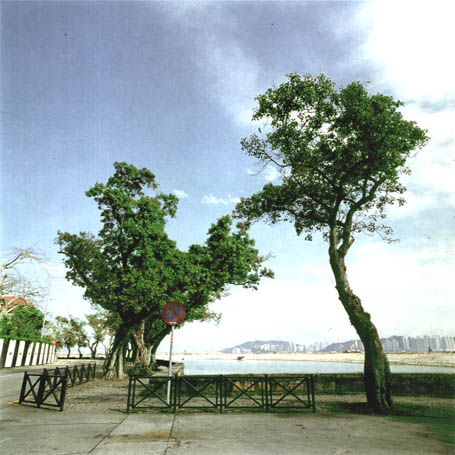
Old trees bordering the Av. da Rep~'ublica (Republic Avenue), Macao.
Photograph taken in 1998 by Amilcar Carvalho.
CHAPTER X
PROVISIONS CONCERNING PUBLIC GARDENS
Article 72 -- It is forbidden to cut, pick flowers or any other plants in public parks, under penalty of ~$S 1 ['Macao Dollar' i. e., Pataca] fine.
Article 73 --The entry of ruffians, beggars, or indecently dressed persons, drunkards or anyone who offends public peace in any way: under penalty of $2 fine."
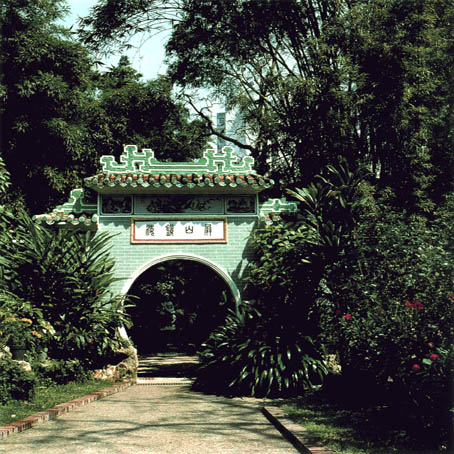
Jardim do Lou Lim Ioc (Lou Lim Ioc Garden), Macao.
Photograph taken in 1998 by Ho-sang Wong.
JARDIM DE S~~AO FRANCISCO (ST. FRANCIS' GARDEN)
1882 -- "The town's main Garden in S~~ao Francisco [St. Francis], at the end of which are the remains of the a waterfall crumbling to pieces, which has been rebuilt, giving it a new lease of life, having also been infested with termites. The Garden is fenced in with banisters which have been repaired.
As the building where the Tribunal da Procuratura [Attorney Court] works from is near St. Francis' Garden, a back yard which was not being used, in spite of the government giving the correct rent to the Mosteiro de Santa Clara [St. Clare's Monastery], arranged to join it to the garden as a public pleasure ground, which is why there are some leafy trees in the area, whose shade should be quite pleasant in the hot season. As St. Francis' Garden has no developed trees, but just bushes and flowers, it should deserve much appreciation with the developing trees which it will have and it will be lovely when it extends into the Largo de S~~ao Francisco [St. Francis' Square], where there are some little cottages, such that they will be incorporated into the garden with the two beautiful and well-formed trees there already."28
1885 -- "[...] few works were carried out there in the last year. They were restricted, prior to my arrival in the Colony, to a ramp with a zig-zag walkway in a place where a supporting wall was weakened by the rains, and I confined myself to ordering stone steps to be placed in this steep, uneven walkway, using compacted concrete to make it last longer, and continuing around the same ramp with the balustrades outside and make other small repairs, either in the kiosks, or in other walkways. The money spent on the garden went mainly on salaries, payments to the manager and labourers working there."29
1888 --"[...] because of its exposure to the southwest monsoon and being closer to the European houses, it attracts a general gathering together mainly in the afternoon when the police guards' 'band' is playing. It seems to me that this enclosure should be handed over to the case of the Senado [Municipal Council], who already pay for the lighting, to foster greater development of popular activities and give it a more suitable appearance for the habits and customs of the Colony's inhabitants."30
JARDIM DO CHUNAMBEIRO
(CHUNAMBEIRO'S GARDEN)
1882 -- "The Jardim do Chunambeiro [Chunambeiro's Garden] is very susceptible to the wind, to such an extent that it has become totally impossible for any sort of delicate plants to thrive there, and for this reason we have made a ball court for the young boys."31
1885 -- "In Chunambeiro's Garden nothing has been done. It is badly beaten by the wind, and only could be frequented in the calm of the evening, if it were tidied up and lit up."32
16th of June 1887 -- Processo n~&o 30 (Procedure no 30) - Series R, from the Administra~'c~~ao Civil de Macau (Macao's Civic Administration) containing documents concerning the repairs to make in Chunambeiro's Garden. 33
THE PRIVATE HORTA DA MITRA
(MITRE'S VEGETABLE-GARDEN)
1882 -- "The following measures have been proposed to the Leal Senado [Municipal Council]:
To quickly see to the unhealthy state of the private garden which is part of the same vegetable garden, with an entrance off Rua do Campo [Campo Street], as there is a sort of reservoir which was probably used for watering, but which is a real swamp with bits of wood, branched and leaves all decomposing, and apart from this, thick woods, a lot of vegetable waste, old wood left out in the sun and rain, and no cleaning up or care taken in anything at all."34
THE JARDIM DA GRUTA DE CAM~~OES
(CAM~~OES' GROTTO GARDEN):
PROPOSAL FOR A MUSEUM, ZOOLOGICAL
AND BOTANICAL GARDEN
1885 -- Borough of Sto. Ant~'onio (St. Anthony' s): "On the north side there is a house or stately home and a very beautiful farm; whose owner up until a short time ago was the Illustrious Comendador (Commander) [Louren~'co Marques], and which now belongs to the Government. The historical Cam~~oes Grotto is in the farm and it is this very important and beautiful property which His Excellency Governor Tom~'as de Sousa Rosa has purchased, as soon as he knew that the owner was negotiating with French Missionaries. For thirty-five-thousand Patacas a patriotic duty was satisfied and already remembered by the illustrious Sociedade de Geografia [Geography Society (of Lisbon)] on the occasion of celebrating three-hundred years of Cam~~oes.
To describe the beauty of that farm, to speak of those gigantic trees, whose roots elaborately embrace the rock, enchant and move the observer, there is no-one here, even myself, able to take on such a task. Such an estate could have many uses, however, I suppose that the best of those I am aware of is for a museum, zoological and botanical garden. The beautiful new museum in Singapore is certainly not in better natural conditions. It so happens that His Excellency Tom~'as de Sousa Rosa has been thinking of a better or more convenient use. It seems there has not been such an important and instructive improvement, believes His Excellency. If it ends up being carried out, it will be another great project by his Government. [...]
Aligned with the entrance to this beautiful enchanting estate are extensive ruins, the remains of two small palaces, sad reminders of the year 1874. They belong to the same Illustrious Commander Louren~'co Marques. They say that the owner tried again to erect them for rent, as he intended part of the palace for himself which was on the southwestern side in front of the long open ground, now built on the ruins of another small palace which the same typhoon, working together with a hungry fire managed to destroy. The same fate fell on the Igreja de Santo Ant~'onio [St. Anthony's Church] which is to the south. Generally buildings of this community are of modest appearance."35
1885 -- "In the Jardim da Gruta de Cam~~oes [Cam~~oes' Grotto Garden], they [i. e., the Macao Government] have carried out more important works. They have erected a large wall which weakens the rain, on which $430.00 [Patacas] was spent. They have opened new walkways, built a small garden with flower beds surrounded by crushed stones in different colours, they brought many decorative plants from Canton [Guangdong], cemented several paths, applying a mixture so as to withstand the rains, as in fact they have succeeded in doing, built a nursery with plots surrounded by red bricks, provisionally erected a bamboo and ola [palm leaves] kiosk for a music band, twenty wooden seats have been ordered, which cost $20.00, they have spiked at all the stone steps there and other projects were done to beautify and decorate.
The site, recently acquired by the Government, deserves being given the greatest attention, not only because of the historical tradition surrounding it, but for bring one of the two most beautiful and pictures que places in Macao, and I do not hesitate in admitting that this administration has neither the time for the personnel to take care of it properly.
And it is on this site, which has a Grotto where, si vera est forma, our celebrated epic poet, Lu~'is de Cam~~oes, wrote part of his magnificent poem, known throughout the civilised world today, and translated into all languages.
This very beautiful Grotto was discovered behind a colonnade of masonry, and covered with a wooden grill, which was quite ugly and a kiosk had been built above it, in bad taste and in a state of disrepair. It was all pulled down with just nature's work left, though later this place should be improved on aesthetically.
What needs to be done? A great deal, but the budget assigned is so small that little is left after paying the ordinary costs, which is a pity. This is the perfect spot for a lake, whose water, driven up from the exiting springs by pumps, would come down to form a fountain. There is space to house some very rare animals, and thereby turn into a zoological curiosity, and the nursery, already mentioned, is magnificently ready to distribute there, by species, varieties and families, different plants, being able to make a detailed study of the Colony's flora which is undoubtedly useful and instructive.
However in spite of all this, the lack of means, time and personnel, I would never neglect this place, which the city of Macao should appreciate a lot as it is so dear to them for many reasons."36
1885-- "Although the process for the acquisition of the Lu~'is de Cam~~oes' [Grotto] Garden had been initiated by the past Capit~~ao do Porto [Port Captain] of Macao, Jo~~ao Eduardo Scarnichia, when the deputy in the Lisbon parliament in May of 1880, because the wish of the Fathers of the Foreign Missions of Paris was to build a convalescing home, the process was taken up again. This was how the Governor, Tom~~as de Sousa Rosa, telegraphed the Ministro da Marinha e Ultramar [Naval and Overseas Territories Minister], Manuel Pinheiro Chagas, and duly authorised, anticipating the French, and bought the property from the [Louren~'co] Marques family."37
1886-- "In the Chunambeiro's Garden, S~~ao Francisco [St. Francis] and the Gruta [(Cam~~oes') Grotto], nothing new has been done, except the later which now has a small pond where water coming from a reservoir placed up high falls in the form a fountain. Money spent in the gardens this year was money just for their upkeep."38
1888 --"[...] the Cam~~oes Grotto [Garden] is well frequented by foreigners as it contains the commemorative monument which A. [Almeida] Garrett brought to light, [...]."39
THE JARDIM DA FLORA (FLORA'S GARDEN)
1883 -- [...] the building of nurseries continues at a fast pace for which the area in the Jardim da Flora [Flora's Garden] has been chosen. It is a small space enclosed by the garden's wall to the south and by a wall along which the water pipe runs beside the road.
It was a sloping area full of holes to such an extent that lot of work was necessary in order to level out and compose a way to make it right. The nursery is divided into two parts, one for stakes and another for seeds, being separated by an esplanade of forty metres in width surrounded by alianthus and grevilhas and other species, which break the monotony of the nursery and make it a truly lovely place."40
1887 -- The Count of Arnoso relates in his book: "The small Flora Palace, which is also the Governor's house, is very beautiful. There, next to a Le N~^otre style garden, we can see a nursery from where the trees existing currently on the Macao hills were taken."41
1888 -- "[...] using some of it for taking care of a tree nursery intended for supplying tree planting generally."42
THE GARDEN IN FRONT OF THELEAL SENADO (MUNICIPAL COUNCIL)
22nd of April 1887 -- Processo n~&o94 (Procedure no 94) - Series E, from the Administra~'c~~ao Civil de Macau (Macao's Civic Administration) regards the beautification of the Garden in front of the Leal Senado [Municipal Council]. The Garden is today remodelled with a complete covering of 'cal~'cada ~`a Portuguesa' ('Portuguese Pavement') and is transformed into a huge public square for pleasure in the heart of the city. 43
THE BEAUTIFICATION OF THE LARGO DE CAM~~OES (CAM~~OES SQUARE)
1st of June 1887 -- Processo n~&o 97 (Procedure no 97) - Series E, from the Administra~'c~~ao Civil de Macau (Macao's Civic Administration) regard the beautification project for Pra~'ca Lu~'is de Cam~~oes (Lu~'is de Cam~~oes Square)."44
Almost half a century later this green revolution of methodical tree planting and landscape gardening, which transformed Macao's Territory into a beautiful and delightful place, another revolution was established there, that of reinforced concrete in a city which would grow obligatorily in height, forgetting some of the most fundamental principles of urban ecology, mainly the concept of a New City for the twenty first century. In Macao, as far as symbols go, the old trees which remain part of the city's fabric, seem to have resisted the eclipse of memory of those handful of men, like Tom~'as de Sousa Rosa, L~'ucio A. da Silva, Dem~'etrio Cinatti, Constantino de Brito, Tancredo Caldeira do Casal Ribeiro, Jos~'e Maria de Sousa Horta e Costa, Augusto C~'esar de Abreu Nunes, and Castelo Branco who, apart form the duties they performed, unselfishly set about launching the roots of a Macao worthy of the twentieth century.
Translated from the Portuguese by: Linda Pearce
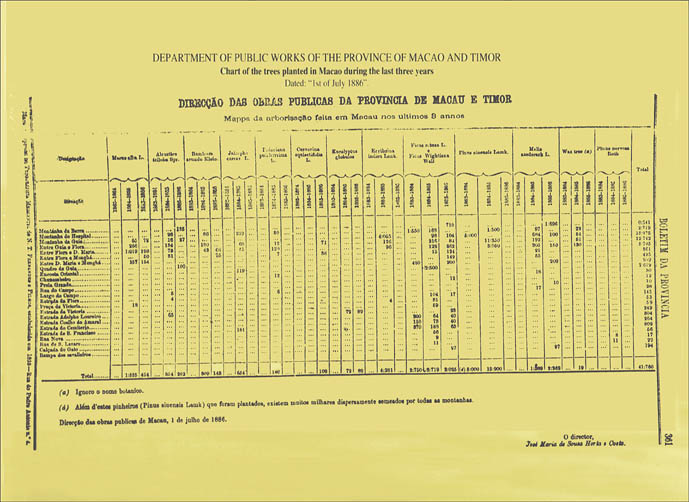
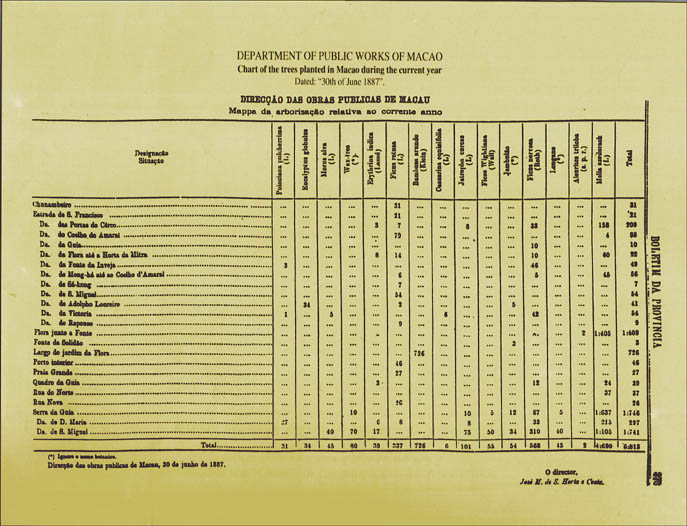
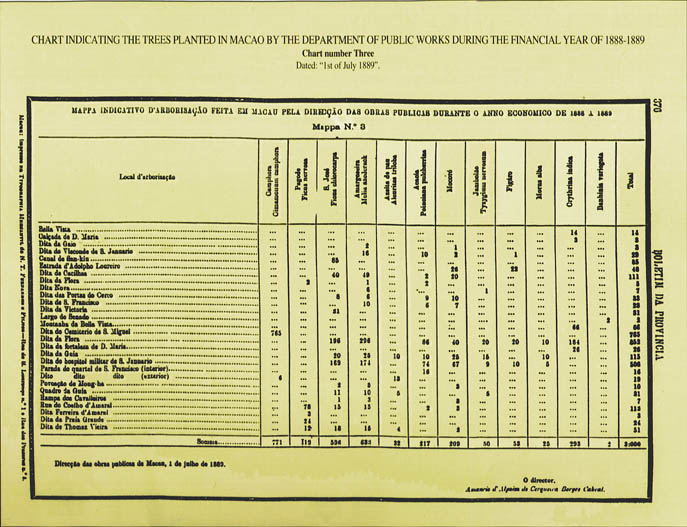
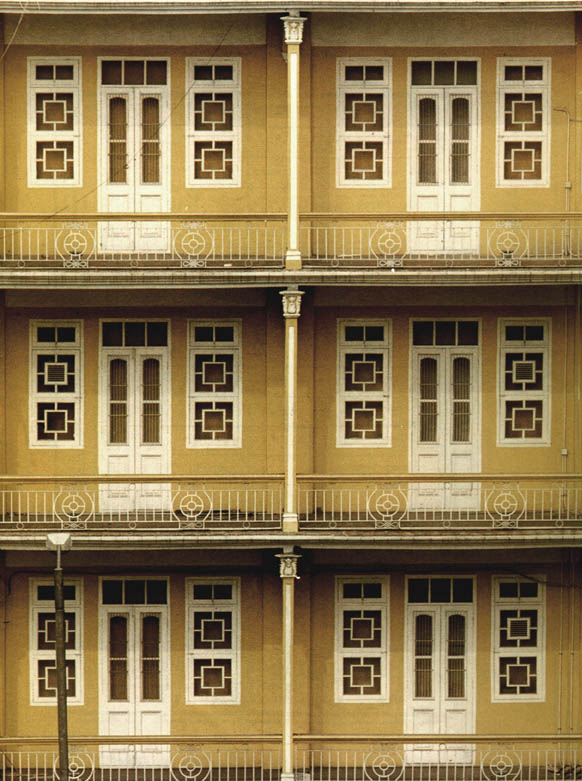
PREVIOUS PAGE:
Avenida Almeida Ribeiro (Almeida Ribeiro Avenue)
QIAN DA LIU
QIAN DA LIU Photograph. Dated.
[Botanical names not known]
NOTES
1 Relat~'orio no 224 da Procuratura os Neg~'ocios S~'inicos (Report no 224 of the Chinese Affairs Bureau), "Boletim da Prov~'incia de Macau e Timor" ("Bulletin of the Province of Macao and Timor"), 31 Outubro (October) 1874, p.186.
2 [?] in "Boletim do Governo de Macau" ("Bulletin of the Government of Macao"), Macau, 12 Janeiro (January)1856, pp.45-46.
3 SILVA, Beatriz Basto da, Cronologia da Hist~'oria de Macau (Chronology of the History of Macao), Direc~'c~~ao dos Servi~'cos de Educa~'c~~ao e Juventude, 1992-1998, Macau, vol. 3.
4 TEIXEIRA, Manuel, Topon~'imia de Macau (Toponymy of Macao), Macau, Imprensa Nacional, 1979, p.506.
5 SILVA, Beatriz Basto da, op. cit., p.277
6 SILVA, L~'ucio Augusto da, Pref~'acio (Preface), in "Report of the Cholera Epidemnic in Macao in 1862" ("Relat~'orio Sobre a Epidemia de cholera-Morbus em Macau no Anno de 1862"), in "Revista M~'edica Portuguesa" ("Portuguese Medical Review"), (9) 1864.
7 LEMOS, Augusto Pereira Tovar de, Relat~'orio do Servi~'co M~'edico da Prov~'incia de Macau e Timor (Report of the Medical Service of the Province of Macao and Timor) [Dated the 1st of February 1886], in "Boletim da Prov~'incia de Macau e Timor" ("Bulletin of the Province of Macao and Timor"), 1 Fevereiro (February) 1886, p.163.
8 COATES, Austin, Macau; Cal~'cadas da Hist~'oria, Macau,Instituto Cultural de Macau, 1991.
9 BRITO, Constantino Jos~'e de, Relat~'orio da Direc~'c~~ao das Obras P~'ublicas da Prov~'incia de Macau e Timor relativo ao Ano de 1882 (Report from Administration of Public Works in the Province of Macao and Timor referring to the Year 1882) [Dated the 30th of January 1883], in "Boletim da Prov~'incia de Macau e Timor" ("Bulletin of the Province of Macao and Timor"), 15 Fevereiro (February) 1883 -- Addendum to no 6, pp.41-47.
10 RIBEIRO, Tancredo Caldeira do Casal, Relat~'orio da Arboriza~'c~~ao de Macau, relativo a Junho de 1883-1884 (Report on Tree Planting in Macao, referring to June 1883 - June 1884), in "Boletim da Prov~'incia de Macau e Timor" ("Bulletin of the Province of Macao and Timor"),20 Junho (June) 1885, pp.266-267.
11 SILVA, L~'ucio Augusto da Silva, Report [...], in "Boletim do Governo de Macau" ("Bulletin of the Government of Macao), Macau, 1870.
12 C~'odigo de Posturas Municipais (Code of Town Ordinances),in "Boletim da Prov~'incia de Macau e Timor" ("Bulletin of the Province of Macao and Timor"), 1872, p.122.
13 BRITO, Constantino Jos~'e de, op. cit.
14 Idem.
15 SILVA, L~'ucio Augusto da, Relat~'orio do Servi~'co de Sa~'ude P~'ublica na Cidade de Macau, relativo ao Ano de 1882(Report from the Public Health Service of Macao, referring to the Year 1882), in "Boletim da Prov~'incia de Macau e Timor" ("Bulletin of the Province of Macao and Timor"),1883, pp.188-211.
16 Informa~'c~~ao no 27 (Information no 27), [Dated the 9th of May 1882 and signed by the administrator of the council of Taipa and Coloane, to the secretary general of the Province of Macao and Timor], in "Boletim da Prov~'incia de Macau e Timor" ("Bulletin of the Province of Macao and Timor"), 1882, p.158.
17 SILVA, L~'ucio Augusto da, 1883, op. cit.
18 Idem.
19 BRITO, Constantino Jos~'e de Brito- SILVA, L~'ucio Augusto da, FERREIRA, Leon~'icio Alfredo - SILVA, Miguel Ayres da Silva, RIBEIRO, Tancredo Caldeira do Casal, Relat~'orio da Comiss~~ao Encarregada de Estudar os Melhoramentos da Cidade de Macau, criada pela Portaria Provincial n.~&o 89 de 28 de Julho de 1883 (Report from the Commission in Charge of Studying Improvements to the City of Macao, Created by the Provincial Government Regulation no 89 of the 28th July of 1883), [Dated the 20th of November 1883], in "Boletim da Prov~'incia de Macau e Timor" ("Bulletin of the Province of Macao and Timor"), 5 Janeiro (January) 1884, pp.2-7.
20 RIBEIRO, Tancredo Caldeira do Casal, op. cit., p.279.
21 LEMOS, Augusto Pereira Tovar de, Relat~'orio do Servi~'co M~'edico da Prov~'incia de Macau e Timor (Report from the Medical Service on the Province of Macao and Timor), referring to the Year 1885, [Dated the 1st of February 1886], in "Boletim da Prov~'incia de Macau e Timor" ("Bulletin of the Province of Macao and Timor"), 1886, p.149.
22 Ibidem., p.163.
23 COSTA, Jos~'e Maria de Sousa Horta e, Relat~'orio da Direc~'c~~ao das Obras P~'ublicas da Prov~'incia de Macau e Timor, relativo ao Ano de 1885 (Report from the Administration of Public Works of the Province of Macao and Timor, referring to the Year 1885), [Dated the 1st of July 1886], page 357, in "Boletim da Prov~'incia de Macau e Timor" ("Bulletin of the Province of Macao and Timor"),14 Setembro (September) 1886, Addendum to no 36,p.357.
24 COSTA, Jos~'e Maria de Sousa Horta e, Relat~'orio sobre bras P~'ublicas, relativo ao Ano de 1886 (Report on Public Works, referring to the Year 1887), in "Boletim da Prov~'incia de Macau e Timor" ("Bulletin of the Province of Macao and Timor"), 3 Novembro (November) 1887, p.379.
25 LOUREIRO, Adolpho, No Oriente -- De N~'apoles ~`aChina (In the Orient -- From Naples to China), Lisboa,Imprensa Nacional, 1897, p. [?].
26 ARNOSO, Conde de, Jornadas pelo mundo (Travels around the World), Porto, Companhia Portugueza Editora,1916, p. l16. Also see: ARNOSO, Conde de, Jornadas pelo mundo (Travels around the World), apud CALDEIRA, Carlos Jos~'e,Macau en 1850, Lisboa, Editores Quetzal, 1997, pp.64-65.
27 CABRAL, Am~^ancio de Alpoim de Cerqueira Borges,Relat~'orio sobre as Obras P~'ublicas, relativo ao Ano Econ~'omico de 1888 a 1889 (Report on Public Works, referring to the financial Year of 1888 to 1889), [Dated the 1st of July 1889], in "Boletim da Provincia de Macau e Timor" ("Bulletin of the Province of Macao and Timor"),3 Dezembro (December) 1889, Addendum to no 48, p.372.
28 BRITO, Constantino Jos~'e de, op. cit.
29 COSTA, Jos~'e Maria de Sousa Horta e, 1886, op. cit.,p.356.
30 CABRAL, Am~^ancio de Alpoim de Cerqueira Borges,1889, op. cit., p.371.
31 BRITO, Constantino Jos~'e de, op. cit.
32 COSTA, Jos~'e Maria de Sousa Horta e, 1886, op. cit.,p.356.
33 SILVA, Beatriz Basto da, op. cit., p.301.
34 SILVA, L~'ucio Augusto da Silva, 1883, op. cit.
35 LEMOS, Augusto Pereira Tovar de, op. cit.
36 COSTA, Jos~'e Maria de Sousa Horta e Costa, 1886, op.cit., p.356.
37 SILVA, Beatriz Basto da, op. cit., p.294.
38 COSTA, Jos~'e Maria de Sousa Horta e Costa, 1887, op.cit., p.370.
39 CABRAL, Am~^ancio de Alpoim de Cerqueira Borges,1889, op. cit., p.371.
40 RIBEIRO, Tancredo Caldeira do Casal, op. cit., pp.266-267.
41 ARNOSO, Conde de, op. cit., p. [?].Also see: ARNOSO, Conde de, Jornadas pelo mundo (Travels around the World), apud TEIXEIRA, Manuel,Macau as Seen by the Count of Arnoso, in "Review of Culture, Macau, Instituto Cultural de Macau, (7-8) October 1988 - March 1989, pp.61-75, p.68.
42 CABRAL, Am~^ancio de Alpoim de Cerqueira Borges,1889, op. cit., p.371.
43 SILVA, Beatriz Basto da, op. cit., p.300
44 Idem.
* Architect. Published articles on architecture and town planning in Portuguese newspapers (Di~'ario de Not~'icias, Jornal do Fund~~ao, and others) and periodicals (Arte Opini~~ao, Sema, and others).
start p. 217
end p.